
Apollo 12 was the sixth crewed flight in the United States Apollo program and the second to land on the Moon. It was launched on November 14, 1969, by NASA from the Kennedy Space Center, Florida. Commander Charles "Pete" Conrad and Lunar Module Pilot Alan L. Bean performed just over one day and seven hours of lunar surface activity while Command Module Pilot Richard F. Gordon remained in lunar orbit.

Apollo 14 was the eighth crewed mission in the United States Apollo program, the third to land on the Moon, and the first to land in the lunar highlands. It was the last of the "H missions", landings at specific sites of scientific interest on the Moon for two-day stays with two lunar extravehicular activities.

Apollo 16 was the tenth crewed mission in the United States Apollo space program, administered by NASA, and the fifth and penultimate to land on the Moon. It was the second of Apollo's "J missions", with an extended stay on the lunar surface, a focus on science, and the use of the Lunar Roving Vehicle (LRV). The landing and exploration were in the Descartes Highlands, a site chosen because some scientists expected it to be an area formed by volcanic action, though this proved not to be the case.

Apollo 17 was the eleventh and final mission of NASA's Apollo program, the sixth and most recent time humans have set foot on the Moon or traveled beyond low Earth orbit. Commander Gene Cernan and Lunar Module Pilot Harrison Schmitt walked on the Moon, while Command Module Pilot Ronald Evans orbited above. Schmitt was the only professional geologist to land on the Moon; he was selected in place of Joe Engle, as NASA had been under pressure to send a scientist to the Moon. The mission's heavy emphasis on science meant the inclusion of a number of new experiments, including a biological experiment containing five mice that was carried in the command module.

The Apollo spacecraft was composed of three parts designed to accomplish the American Apollo program's goal of landing astronauts on the Moon by the end of the 1960s and returning them safely to Earth. The expendable (single-use) spacecraft consisted of a combined command and service module (CSM) and an Apollo Lunar Module (LM). Two additional components complemented the spacecraft stack for space vehicle assembly: a spacecraft–LM adapter (SLA) designed to shield the LM from the aerodynamic stress of launch and to connect the CSM to the Saturn launch vehicle and a launch escape system (LES) to carry the crew in the command module safely away from the launch vehicle in the event of a launch emergency.
A geophone is a device that converts ground movement (velocity) into voltage, which may be recorded at a recording station. The deviation of this measured voltage from the base line is called the seismic response and is analyzed for structure of the Earth.

Apollo 15 lunar surface operations were conducted from July 30 to August 2, 1971, by Apollo 15 Commander David Scott and Apollo Lunar Module Pilot James Irwin, who used the first Lunar Roving Vehicle to make three exploratory trips away from their landing site at the base of the Apennine Mountains, near Hadley Rille.

The ALSE (Apollo Lunar Sounder Experiment) (also known as Scientific Experiment S-209, according to NASA designations) was a ground-penetrating radar (subsurface sounder) experiment that flew on the Apollo 17 mission.
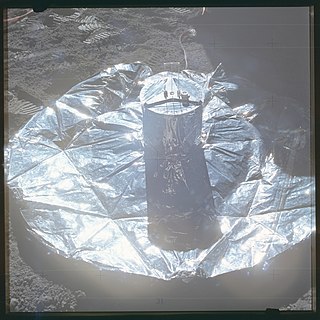
Lunar seismology is the study of ground motions of the Moon and the events, typically impacts or moonquakes, that excite them.
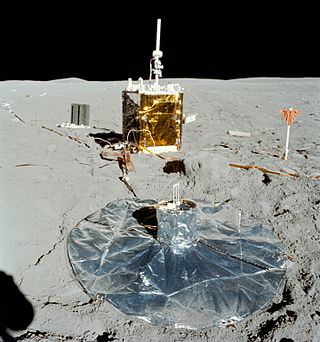
The Apollo Lunar Surface Experiments Package (ALSEP) comprised a set of scientific instruments placed by the astronauts at the landing site of each of the five Apollo missions to land on the Moon following Apollo 11. Apollo 11 left a smaller package called the Early Apollo Scientific Experiments Package, or EASEP.

The Lunar Flag Assembly (LFA) was a kit containing a flag of the United States designed to be erected on the Moon during the Apollo program. Six such flag assemblies were planted on the Moon. The nylon flags were hung on telescoping staffs and horizontal bars constructed of one-inch anodized aluminum tubes. The flags were carried on the outside of the Apollo Lunar Module (LM), most of them on the descent ladder inside a thermally insulated tubular case to protect them from exhaust gas temperatures calculated to reach 2,000 °F (1,090 °C). The assembly was designed and supervised by Jack Kinzler, head of technical services at the Manned Spacecraft Center (MSC) in Houston, Texas. Six of the flags were ordered from a government supply catalog and measured 3 by 5 feet ; the last one planted on the Moon was the slightly larger, 6-foot (1.8 m)-wide flag which had hung in the MSC Mission Operations Control Room for most of the Apollo program.
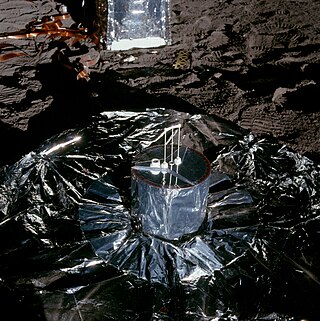
The Apollo 12 Passive Seismic Experiment (PSE) was placed on the lunar surface by the Apollo 12 mission as part of the Apollo Lunar Surface Experiments Package (ALSEP). The PSE was designed to detect vibrations and tilting of the lunar surface and measure changes in gravity at the instrument location. The vibrations are due to internal seismic sources (moonquakes) and external. The primary objective of the experiment was to use these data to determine the internal structure, physical state, and tectonic activity of the Moon. The secondary objectives were to determine the number and mass of meteoroids that strike the Moon and record tidal deformations of the lunar surface.

The Apollo 14 Passive Seismic Experiment (PSE) was placed on the lunar surface on February 5, 1971, as part of the Apollo 14 ALSEP package. The PSE was designed to detect vibrations and tilting of the lunar surface and measure changes in gravity at the instrument location. The vibrations are due to internal seismic sources (moonquakes) and external. The primary objective of the experiment was to use these data to determine the internal structure, physical state, and tectonic activity of the Moon. The secondary objectives were to determine the number and mass of meteoroids that strike the Moon and record tidal deformations of the lunar surface.

Active Seismic Experiment (ASE) was carried on Apollo 14 and Apollo 16 as part of the Apollo Lunar Surface Experiments Package (ALSEP). ASE used a thumper device and a mortar with explosive charges to explore subsurface lunar structure and elastic properties. The experiment's principal investigator was Robert Kovach of Stanford University. The experiment was succeeded on Apollo 17 by the Lunar Seismic Profiling experiment.
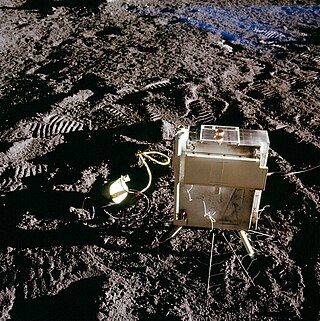
The Cold Cathode Gauge Experiment, also known as the Lunar Atmosphere Detector, was a scientific package that flew on board Apollo 12, Apollo 13, Apollo 14, and Apollo 15. The goal of the experiment was to measure the density of the Moon's tenuous atmosphere, but not its composition.
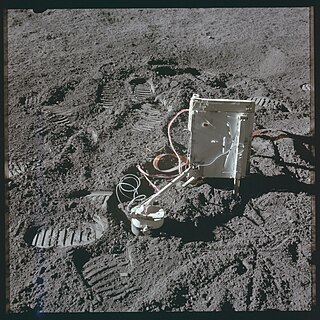
The Suprathermal Ion Detector Experiment (SIDE) was a lunar science experiment, first deployed by astronauts on the lunar surface in 1969 as part of Apollo 12, and later flying on Apollo 14 and Apollo 15. The goal of SIDE was to study any potential lunar ionosphere and the solar wind.
The Lunar Atmospheric Composition Experiment (LACE) was a miniature magnetic deflection mass spectrometer. The experiment's aim was to study the composition and variations of the lunar atmosphere. The only deployment of LACE was as part of the Apollo Lunar Surface Experiments Package (ALSEP) on Apollo 17 within the Taurus–Littrow valley.

The Passive Seismic Experiment Package (PSEP) was a scientific experiment deployed on the lunar surface by the astronauts of Apollo 11 as part of the Early Apollo Surface Experiments Package (EASEP). The experiment's goal was to determine the structure, tectonic activity, physical nature, and composition of the Moon. PSEP was the first seismometer to be deployed on a planetary body other than Earth.

The Solar Wind Spectrometer was a scientific package that flew on the Apollo 12 and Apollo 15 missions to the surface of the Moon. The goal was to characterise the solar wind near the Moon's surface and to explore its interactions with the lunar environment. The experiments' principal investigator was Dr Conway W. Snyder of the Jet Propulsion Laboratory.

The Lunar Surface Gravimeter (LSG) was a lunar science experiment that was deployed on the surface of the Moon by the astronauts of Apollo 17 on December 12, 1972. Conceived and led by Joseph Weber as principal investigator, the experiment aimed to measure changes in the local gravitational strength on the Moon's surface. These measurements were intended to provide insight into the internal structures of the Moon as it tidally deformed due interaction with the gravitational fields of the Earth and Sun. In addition the experiment hoped to contribute experimental evidence of the existence of gravitational waves.



















